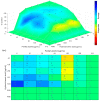Hydrocinnamic Acid and Perillyl Alcohol Potentiate the Action of Antibiotics against Escherichia coli
- PMID: 36830271
- PMCID: PMC9952493
- DOI: 10.3390/antibiotics12020360
Hydrocinnamic Acid and Perillyl Alcohol Potentiate the Action of Antibiotics against Escherichia coli
Abstract
The treatment of bacterial infections has been troubled by the increased resistance to antibiotics, instigating the search for new antimicrobial therapies. Phytochemicals have demonstrated broad-spectrum and effective antibacterial effects as well as antibiotic resistance-modifying activity. In this study, perillyl alcohol and hydrocinnamic acid were characterized for their antimicrobial action against Escherichia coli. Furthermore, dual and triple combinations of these molecules with the antibiotics chloramphenicol and amoxicillin were investigated for the first time. Perillyl alcohol had a minimum inhibitory concentration (MIC) of 256 µg/mL and a minimum bactericidal concentration (MBC) of 512 µg/mL. Hydrocinnamic acid had a MIC of 2048 µg/mL and an MBC > 2048 µg/mL. Checkerboard and time-kill assays demonstrated synergism or additive effects for the dual combinations chloramphenicol/perillyl alcohol, chloramphenicol/hydrocinnamic acid, and amoxicillin/hydrocinnamic acid at low concentrations of both molecules. Combenefit analysis showed synergism for various concentrations of amoxicillin with each phytochemical. Combinations of chloramphenicol with perillyl alcohol and hydrocinnamic acid revealed synergism mainly at low concentrations of antibiotics (up to 2 μg/mL of chloramphenicol with perillyl alcohol; 0.5 μg/mL of chloramphenicol with hydrocinnamic acid). The results highlight the potential of combinatorial therapies for microbial growth control, where phytochemicals can play an important role as potentiators or resistance-modifying agents.
Keywords: antibiotic recalcitrance; combinatorial therapy; hydrocinnamic acid; perillyl alcohol; phytochemical-antibiotic interaction; plant-based natural product.
Conflict of interest statement
The authors declare no conflict of interest.
Figures







Similar articles
-
Hydrocinnamic acid and perillyl alcohol are effective against Escherichia coli biofilms when used alone and combined with antibiotics.J Appl Microbiol. 2023 Oct 4;134(10):lxad234. doi: 10.1093/jambio/lxad234. J Appl Microbiol. 2023. PMID: 37827567
-
Effects and time-kill assessment of amoxicillin used in combination with chloramphenicol against bacteria of clinical importance.Acta Biochim Pol. 2017;64(4):609-613. doi: 10.18388/abp.2016_1495. Epub 2017 Nov 30. Acta Biochim Pol. 2017. PMID: 29202138
-
Pharmacological synergism of bee venom and melittin with antibiotics and plant secondary metabolites against multi-drug resistant microbial pathogens.Phytomedicine. 2015 Feb 15;22(2):245-55. doi: 10.1016/j.phymed.2014.11.019. Epub 2015 Jan 5. Phytomedicine. 2015. PMID: 25765829
-
A review on antimicrobial botanicals, phytochemicals and natural resistance modifying agents from Apocynaceae family: Possible therapeutic approaches against multidrug resistance in pathogenic microorganisms.Drug Resist Updat. 2020 Jul;51:100695. doi: 10.1016/j.drup.2020.100695. Epub 2020 Apr 8. Drug Resist Updat. 2020. PMID: 32442892 Review.
-
Antibiotic resistance modifying ability of phytoextracts in anthrax biological agent Bacillus anthracis and emerging superbugs: a review of synergistic mechanisms.Ann Clin Microbiol Antimicrob. 2021 Dec 2;20(1):79. doi: 10.1186/s12941-021-00485-0. Ann Clin Microbiol Antimicrob. 2021. PMID: 34856999 Free PMC article. Review.
Cited by
-
Perillyl Alcohol Promotes Relaxation in Human Umbilical Artery.Curr Med Chem. 2024;31(42):7072-7082. doi: 10.2174/0109298673269428231204064101. Curr Med Chem. 2024. PMID: 38204229
-
Impacts of Hydrophobic Mismatch on Antimicrobial Peptide Efficacy and Bilayer Permeabilization.Antibiotics (Basel). 2023 Nov 14;12(11):1624. doi: 10.3390/antibiotics12111624. Antibiotics (Basel). 2023. PMID: 37998826 Free PMC article.
-
Identification of Bacterial Metabolites Modulating Breast Cancer Cell Proliferation and Epithelial-Mesenchymal Transition.Molecules. 2023 Aug 5;28(15):5898. doi: 10.3390/molecules28155898. Molecules. 2023. PMID: 37570868 Free PMC article.
References
-
- Dhingra S., Rahman N.A.A., Peile E., Rahman M., Sartelli M., Hassali M.A., Islam T., Islam S., Haque M. Microbial Resistance Movements: An Overview of Global Public Health Threats Posed by Antimicrobial Resistance, and How Best to Counter. Front. Public Health. 2020;8:535668. doi: 10.3389/fpubh.2020.535668. - DOI - PMC - PubMed
Grants and funding
LinkOut - more resources
Full Text Sources

